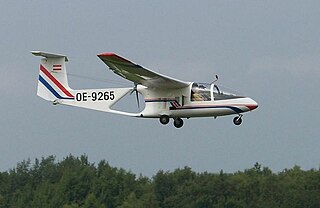Related Research Articles

The Schempp-Hirth Janus is a high performance two-seat glider that was built by Schempp-Hirth GmbH. It was the first high-performance two-seater.

The Glaser-Dirks DG-400 is a single-seat self-launching motorglider that was produced by Glaser-Dirks between 1981 and 1992. It was the first self-launching motorglider with retractable engine and propeller to be produced in large numbers.

The Brditschka HB-3, HB-21 and HB-23 are a family of motor gliders of unorthodox configuration developed in Austria in the early 1970s.

The Glaser-Dirks DG-500, and later the DG-505, is a two-seat glider of glass-reinforced plastic and carbon fiber reinforced plastic construction, manufactured in the DG Flugzeugbau GmbH in Bruchsal, Germany. It first flew in 1987.

The Caproni Vizzola C22 Ventura was a light jet-powered aircraft developed in Italy for use as a military trainer. It was of conventional sailplane configuration and bore a family resemblance to the Caproni Calif gliders, although the Ventura had an almost entirely metal structure. The student and instructor sat side by side under an expansive canopy, and weapons hardpoints were provided under each of the slender, high-mounted wings. It had retractable, tricycle undercarriage.

The ICA IS-28 is a two-seat sailplane produced in Romania in the 1970s. An all-metal aircraft of conventional design with a T-tail, it was originally produced with 15-metre wings, but in 1973, production shifted to the IS-28B with 17-metre wings and numerous aerodynamic refinements. These included a smaller tail with decreased dihedral, decreased dihedral on the wings, and redesigned fuselage contours. This version first flew on 26 April 1973 and was subsequently produced in versions with flaps (IS-28B2) and without (IS-28B1). Around 100 had been built by the early 1980s, with a substantial number sold for export. On April 7, 1979, Tom Knauff and R. Tawse set a world record with the IS-28 B2 glider, covering a distance of 829 kilometres on a predetermined out-and-return course from the Ridge Soaring Gliderport in Julian, Pennsylvania.
The ICA IS-32 is an open class high-performance metal two-seat sailplane produced in Romania in the 1970s. A refinement of the IS-28B, it shared most of that aircraft's fuselage, mated to new wings and empennage. This new wing had a span of 20 metres, featuring interconnected ailerons and flaps, Schempp-Hirth-type airbrakes. It had no provision for water ballast. The monowheel undercarriage differed from the IS-28 in being fully retractable.

The HP-14 is a Richard Schreder-designed all-metal glider aircraft that was offered as a kit for homebuilding during the 1960s and 1970s. It was originally developed by retrofitting improved wings to the fuselage and tail of the HP-13, and first flew in 1966. Schreder won the 1966 US national soaring championship in the prototype HP-14.

The Scheibe SF 34 Delphin is a two-seat sailplane that was produced by Scheibe in Germany in the late 1970s and 1980s. Designed by Wolf Hoffmann and originally designated the SF H34, it was Scheibe's first unpowered aircraft of composite construction.
The Applebay Zia is an American, single-seat, high-wing, twin-boom, pusher configuration motor glider that was designed by George Applebay for the 1982 Sailplane Homebuilders Association Homebuilt Sailplane Design Contest. The aircraft was intended to be offered as a factory completed aircraft or as a kit. It first flew in 1982.
The Oldershaw O-3 is an American high-wing, single seat, V-tailed glider that was designed by Vernon Oldershaw. Two examples were constructed as gliders and then both were later converted to motor gliders.

The FFA Diamant is a family of Swiss high-wing, T-tailed, single-seat, FAI Standard Class and FAI Open Class gliders that was designed by engineering students under supervision of Professor Rauscher at the ETH Zurich and manufactured by Flug- und Fahrzeugwerke Altenrhein AG (FFA) of Altenrhein, Switzerland.
The TeST TST-3 Alpin T is a Czech shoulder-wing, T-tailed, single-seat glider and motor glider that was designed and produced by TeST of Brno.
The Akaflieg Darmstadt D-39 was a single-seat motor glider derived from the D-38 sailplane. Built in Germany in the late 1970s, it was not intended for production and only one was constructed.
The Civil Aviation Department MG-1 was a one-off Indian motor glider, seating two side by side and first flown in 1983.

The Mistral-C was one of the first gliders, designed in 1974 to the then new Club Class rules. It was based on the Strauber Mistral, a Standard Class glider flown a year earlier, but with a new wing and built from newer composite materials. Both types were designed and constructed in Germany. More than 75 Mistral-Cs were produced.
The EFF Prometheus was an unusual two seat motor glider powered by a pair of small turbojet engines, designed and constructed in Switzerland in the 1970s. Two versions with different spans were built, but it did not go into production.
The Nippi NP-100 Albatross was a Japanese two side-by-side seat motorized glider, powered by a ducted fan rather than the usual propeller. It did not go into production.
The Farner HF Colibri 1 SL was an unusual canard motor glider with a unique control system, designed and built in Switzerland in the late 1970s. Only one was constructed; much modified during the 1980s, it was still flying in 1990.
References
- ↑ Taylor, John W. R. (1980). Jane's All the World's Aircraft 1980-1981. London: Jane's Publishing Co. p. 579. ISBN 0-7106-0705-9.
- ↑ John W.R. Taylor, ed. (1988). Jane's All the World's Aircraft 1988-89. London: Jane's Information Group. pp. 640–641. ISBN 0-7106-0867-5.
- 1 2 Team J2MCL. "Aviafiber Canard 2FL". j2mcl-planeurs.net (in French). Retrieved 28 January 2015.
{{cite web}}: CS1 maint: numeric names: authors list (link)